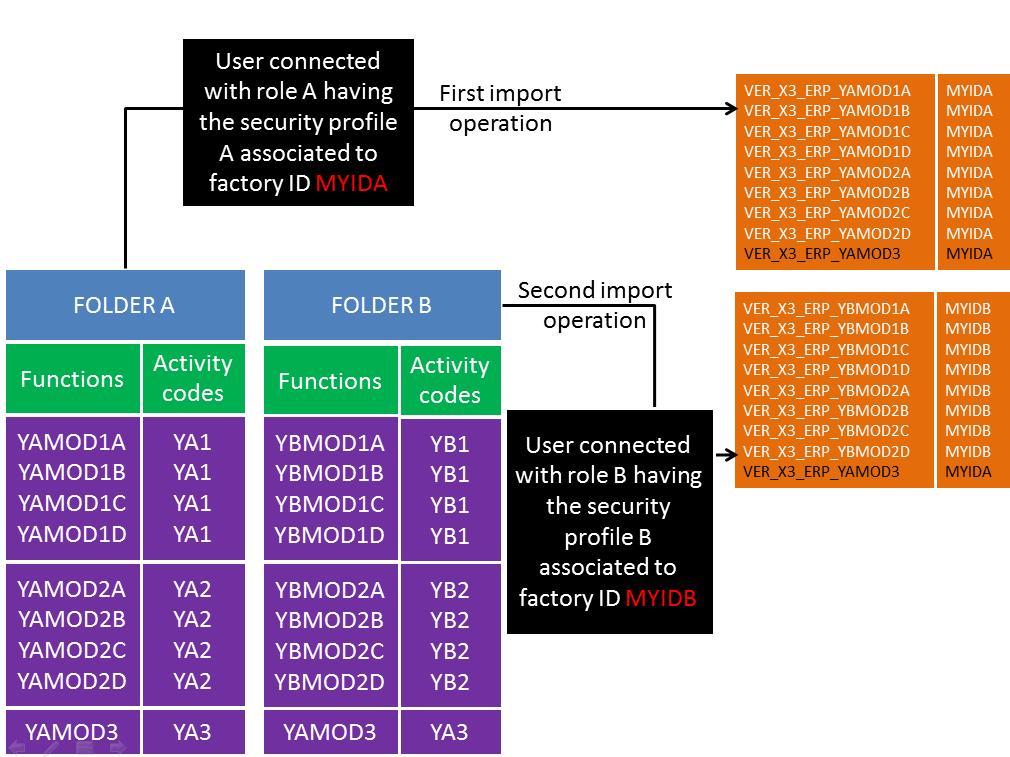
Menu profile import
| Administration Page | Application/Contract | Syracuse/Collaboration | Class | (none) | Representation | menuProfileImport |
|---|
The menu profile import tool allows you to import menu items (from function list) as well as vignettes from the user's portal into the administration repository.
This feature is especially interesting when a folder having bespoke functions is connected to a version 7 web server. All the standard functions of Sage X3 are delivered as menu items in the administration repository, they are not assigned to a given endpoint so they can be used for any X3 endpoint. But of course the bespoke functions cannot be delivered that way, and it is particularly useful to have a function that imports these functions and creates menu items.
Another case where this function is very useful is when the users created a lot of additional personalized portals including vignettes using processes, requests, statistics, or links to web pages. This function will automatically create menu items and portlet from these portal pages definition.
This page can only be called with a working copy (no query or detail facet). Launching the page allows you to enter parameters and to start the import task.
The information to enter is the following:
Defines the endpoint (the X3 folder) from where the data is imported.
When this check box is selected, the menu items description in all the languages declared for the folder are imported.
This grid allows you to select the languages in which the menu item descriptions are imported. This list can be entered only if the Import all active locales check box is cleared.
When this check box is selected, the 'home' Navigation page will be updated based on the 'ADMIN' menu profile of the Endpoint previously selected.
When this check box is selected, the portal description is imported to generate vignettes.
This check box is available if the user that runs this import is connected with a role that has a security profile associated to a factory ID. When this check box is selected, the factory ID will be associated to the imported elements.
This radio button allows you to select one of the different update policies:
Clicking this link triggers the import based on the given parameters.
Clicking this link allows a schedule to be selected so that the process can be automated based on the currently entered parameters.
The import tool creates menu items only for classic functions and V6 vignettes. The naming rules for the functions created is the following:
This means that during an execution of this tool, only one type of naming is used, irrespectively on how the functions are named. For instance:
An important point to note is that the all the functions present on the current folder in the ADMIN menu will be created as menu item if they didn't exist yet. If the user that runs this import is connected with a role that has a security profile associated to a factory ID, the factory ID will be associated to the menu item.
If you want to create menu items associated to different factory IDs, it is important to run the tool from different folders which have only the functions associated to a given factory ID, or to do it in several steps by adding the function to the folders successively before each import.
An example is given by this schema:

In a first step, we import the menu items from folder A. In this folder, we have 3 sets of functions that can be enabled and disabled separately by setting up the activity codes YA1, YA2, YA3. When this is done, the corresponding menu items, starting by VER_X3_ERP_ followed by the function code have been created. As the user running the import function is associated to the MYIDA factory code, all the menu items are associated to this factory code.
In a second step, we import the menu items from folder B. This folder has 3 set of functions associated to YB1, YB2, YA3 activity code (you can see that the last function is exactly the same than in folder A). The integration creates the corresponding menu items, starting by VER_X3_ERP_ followed by the function code. As the user running the import function is associated to MYIDB factory code, all the menu items are associated to this factory code, with the notable exception of the last function, that was already integrated and remains with the factory code MYIDA.
If you are a developer and you develop new classic pages functions in a given folder, using this procedure to create automatically the corresponding menu items in your MongoDB repository with a dedicated factory code is the best way to do it.
To deliver the set of bespoke functions you have developed, you will:
If you want to install a set of functions that have been created beforehand on a customer environment, the best practices are to :